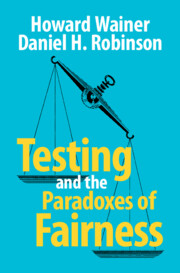Book contents
- Testing and the Paradoxes of Fairness
- Reviews
- Testing and the Paradoxes of Fairness
- Copyright page
- Dedication
- Annotated Table of Contents
- Preface
- Acknowledgments
- Chapter 1 A Brief Recounting of the First Four Millennia of Testing
- Chapter 2 Why Tests Are so Widely Disliked
- Chapter 3 The Origins and Consequences of Mental Testing in the U.S. Military
- Chapter 4 Testing in Grades K-12
- Chapter 5 Licensing Examinations
- Chapter 6 Admission Testing for Higher Education
- Chapter 7 Tests Used for Merit-Based Scholarships
- Chapter 8 Using Student Test Scores to Evaluate Teachers: An Assessment of Value-Added Models
- Chapter 9 Dividing Test Scores into Subcomponents
- Chapter 10 On Cost Functions in Testing
- Chapter 11 Evidence in Science: Should We Use Data and What Data Can We Trust?
- Chapter 12 Three Cautionary Tales of Zombie Ideas about Testing
- Chapter 13 Coda
- References
- Index
Chapter 3 - The Origins and Consequences of Mental Testing in the U.S. Military
Published online by Cambridge University Press: 10 October 2025
- Testing and the Paradoxes of Fairness
- Reviews
- Testing and the Paradoxes of Fairness
- Copyright page
- Dedication
- Annotated Table of Contents
- Preface
- Acknowledgments
- Chapter 1 A Brief Recounting of the First Four Millennia of Testing
- Chapter 2 Why Tests Are so Widely Disliked
- Chapter 3 The Origins and Consequences of Mental Testing in the U.S. Military
- Chapter 4 Testing in Grades K-12
- Chapter 5 Licensing Examinations
- Chapter 6 Admission Testing for Higher Education
- Chapter 7 Tests Used for Merit-Based Scholarships
- Chapter 8 Using Student Test Scores to Evaluate Teachers: An Assessment of Value-Added Models
- Chapter 9 Dividing Test Scores into Subcomponents
- Chapter 10 On Cost Functions in Testing
- Chapter 11 Evidence in Science: Should We Use Data and What Data Can We Trust?
- Chapter 12 Three Cautionary Tales of Zombie Ideas about Testing
- Chapter 13 Coda
- References
- Index
Summary
Armed services tests have existed for centuries. We focus on the US Armed Services and how the tests used have adapted to changed claims associated with changing needs and purposes of the tests. World War I provided the impetus for the first serious military testing program. An all-star group of psychologists convened in Vineland, New Jersey and quickly constructed Army Alpha, which became a model for later group-administered, objective, multiple-choice tests. Military testing was the first program to explicitly move from very specialized tests for specific purposes to testing generalized underlying ability. This made such tests suitable for situations not even considered initially. The practice was both widely followed and just as widely disparaged. The AGCT, AFQT, and ASVAB were later versions of this initial test. Army Alpha also influenced the creation of the SAT, ACT, GRE, LSAT, and MCAT tests. Decisions based on military tests, like all tests, can be controversial. In 1965, Project 100,000 lowered the cut score and resulted in thousands of low-scoring men being drafted, many of whom later died fighting in Vietnam.
Information
- Type
- Chapter
- Information
- Testing and the Paradoxes of Fairness , pp. 24 - 34Publisher: Cambridge University PressPrint publication year: 2025
Accessibility standard: Inaccessible, or known limited accessibility
Why this information is here
This section outlines the accessibility features of this content - including support for screen readers, full keyboard navigation and high-contrast display options. This may not be relevant for you.Accessibility Information
Content Navigation
Allows you to navigate directly to chapters, sections, or non‐text items through a linked table of contents, reducing the need for extensive scrolling.
Provides an interactive index, letting you go straight to where a term or subject appears in the text without manual searching.
Reading Order & Textual Equivalents
You will encounter all content (including footnotes, captions, etc.) in a clear, sequential flow, making it easier to follow with assistive tools like screen readers.
You get concise descriptions (for images, charts, or media clips), ensuring you do not miss crucial information when visual or audio elements are not accessible.
You get more than just short alt text: you have comprehensive text equivalents, transcripts, captions, or audio descriptions for substantial non‐text content, which is especially helpful for complex visuals or multimedia.
Visual Accessibility
You will still understand key ideas or prompts without relying solely on colour, which is especially helpful if you have colour vision deficiencies.
You benefit from high‐contrast text, which improves legibility if you have low vision or if you are reading in less‐than‐ideal lighting conditions.
